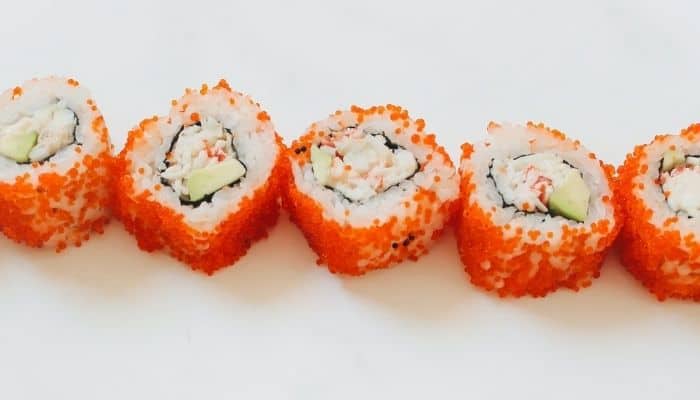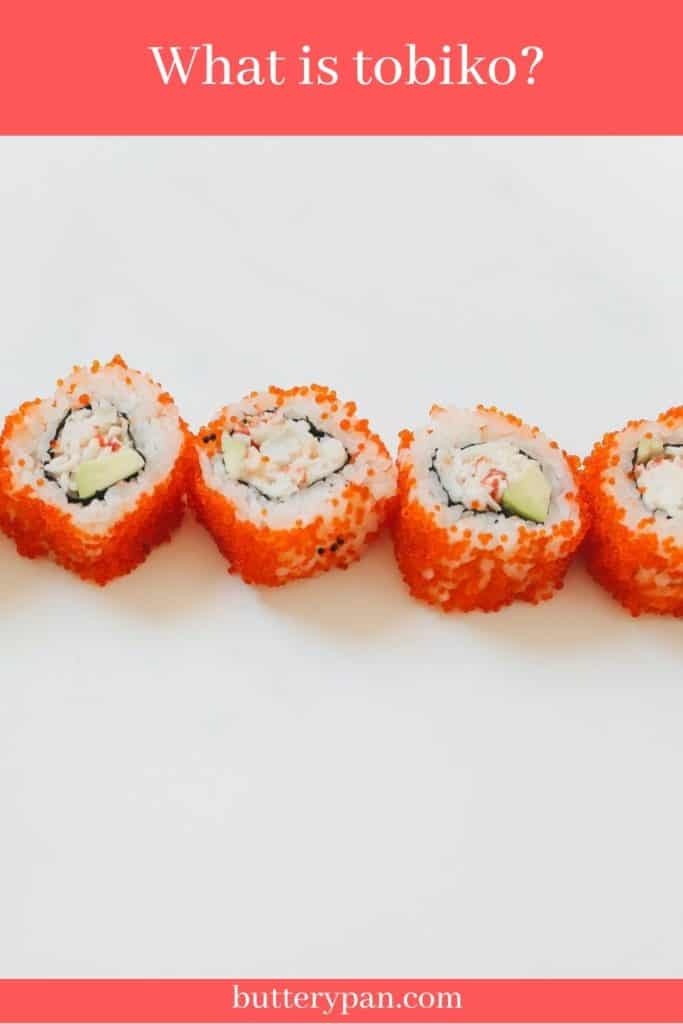What Is Tobiko? Types, Uses, Storage

Wondering what is tobiko? Look no further, in this post I will explain what is tobiko, why is it popular how to eat it, and much more!
Japanese cuisine had become very popular over the years. One dish, which has become very popular in recent years is tobiko (flying fish roe). You can see it on many dishes in Japanese restaurants, in this post we will discuss what tobiko is.
Table of Contents
What is tobiko?
Tobiko is small, red, and orange fish eggs that are popular in Japanese cuisine. They’re often used as a topping for sushi and other dishes.
Tobiko is usually made from flying fish.
Why is tobiko popular?
Tobiko is popular because it is very flavorful and colorful. It adds a great flavor to dishes, especially sushi.
How to eat tobiko?
Tobiko is usually eaten as a topping for sushi. It can be sprinkled or mixed in rice, cooked with vegetables and seafood, put on avocados to create what’s called “tobiko maki”, or used as a garnish on top of dishes such as crabmeat salads.
Tobiko can be eaten on its own, with thin pancakes (called crepes or blini) or it can also be used as a topping for seafood dishes such as shrimp tempura with yuzu sauce and edamame dumplings.

What does tobiko mean?
Tobiko means “flying fish roe”, which is what it comes from.
Types of Tobiko
there are several variations of tobiko:
Red Tobiko
Red tobiko is the most common and popular type. Red tobiko is what you want to use when making sushi, as it will stand out the most among other ingredients such as white fish or shrimp.
It’s also what people usually put on top of dishes, like avocado rolls for a pop of color and flavor. The red coloring from this particular kind of tobiko is a result of what it’s made from: fish eggs and salt.
Orange Tobiko
This type of tobiko is what you want to use when making Japanese omelettes or “tamagoyaki”.
It’s also used in place of red tobiko on top of dishes, like avocado rolls. The orange coloring from this particular kind of tobiko is a result of combining it with yuzu.
White Tobiko
While red tobiko is also very common, there are also white versions that can be found in many Asian markets or online stores. White tobiko comes from squid or other types of seafoods and has a very subtle flavor to it.
Wasabi Tobiko
Wasabi tobiko is a delicious and flavorful addition to your sushi. It’s also a great way to add more heat or spice if you’re looking for something different that what is usually served at the sushi bar.
Hoisin Tobiko
This mixture of tobiko mixed with hoisin sauce creates sweet, salty, and spicy flavor in one bite! Hoisin tobiko is a great way to add a little extra heat and spice.
Black Tobiko
Black tobiko is made of tobiko mixed with black soy sauce. This mixture creates a rich and savory flavor that’s sure to please!
Tobiko Puree
You can blend what you like, but the only ingredients are Tobiko puree (prepared according to package instructions) and water.
Benefits of using tobiko
Firsts and foremost tobiko has great flavor and also comes with other benefits such as being low in calories, cholesterol-free, and a good source of selenium.
Different ways tobiko can be used in cooking
Tobiko is a very versatile garnish. You can see it in sushi, on top of rice dishes, and even in salads.
Also, it is a great addition to sauces, soups, or even noodles. Tobiko can be mostly found in Asia, but you can also see it in meals from other parts of the world.
Tobiko can be found throughout the world but it has become popular as a traditional Japanese ingredient.
There are many different types of tobiko with each country having its own variations such as what color they use or what of meal they add it to.
What is tobiko sushi?
There are many sushi types that use tobiko as a flavor enhancer or just to look better on the plate. It is a common ingredient in maki, nigiri sushi, and sometimes called Temari.
The type of tobiko used on top of the rice dish could depend on what region it’s from or what color they want for their meal.
Tobiko vs Masago
The difference between tobiko and masago is what it is made of and what type of dish it’s used in.
Tobiko is mainly made out of the roe or eggs from larger fish such as trout, salmon, tuna etc. Masago on the other hand can be found in smaller fish-like smelt
Tobiko vs Caviar
The difference between caviar and tobiko, again, comes down to the type of fish. Caviar is what comes from the eggs of sturgeon fish, while tobiko is what comes out of smaller types of fish.
Is tobiko sustainable?
Tobiko is the roe of flying fish and is what happens when they are hunted.
Tobiko is sustainable seafood because the fish that provide it aren’t overfished or endangered and there’s no risk of them being depleted in any way
What does tobiko taste like?
Tobiko’s taste is similar to what a person would expect from caviar, but it’s not as fatty. Tobiko is slightly salty and has a tangy taste to them.
What does tobiko look like?
Tobiko’s look is very similar to what a person would expect from caviar, but at first glance, tobiko is more delicate.
Tobiko looks like small round dots – but they can be of different colors, as described in the previous part of this post.
How much does tobiko cost?
Tobiko prices hugely depend on where do you buy it. To give you a wild shot the prices are somewhere between $200 and $300 per pound.
Where to buy tobiko?
Tobiko can be purchased at most specialty stores, like Whole Foods or the like.
How to store tobiko?
Tobiko should be stored in an airtight container and kept refrigerated.
Is tobiko raw?
If you wondering whether tobiko is raw, the answer is yes.
Is tobiko safe to eat?
If the tobiko is fresh – it is safe to eat.
Summary
So what is tobiko? It is the eggs of flying fish and it can be found on many Japanese dishes. Tobiko has a bright color that enhances any dish, but don’t worry if you want to try eating this amazing food! In this post, we discussed how to prepare your own with step-by-step instructions for all skill levels. If you are ready to give it a go, make sure you refer back to our blog posts as they will help guide your way through cooking up some delicious sushi or sashimi today!